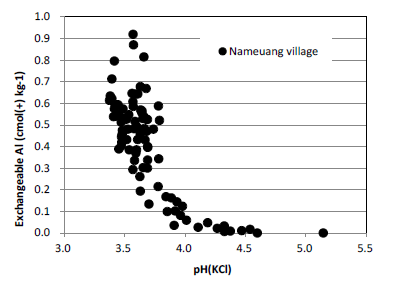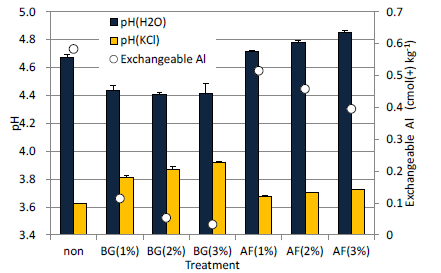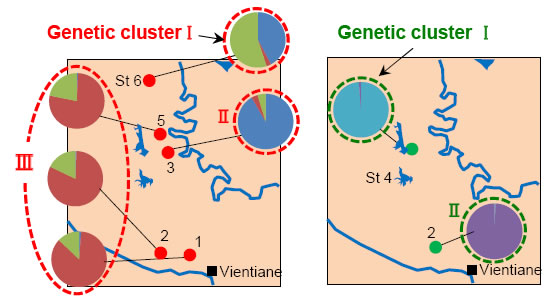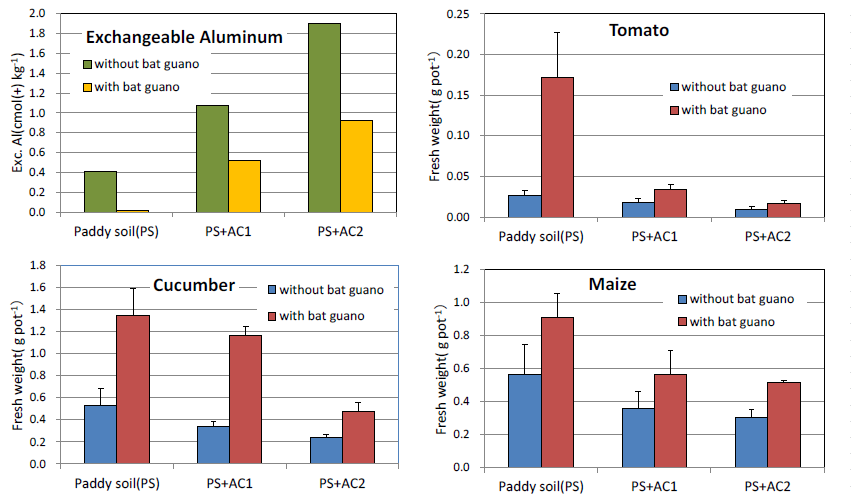Local farmers employ bat guano to overcome soil acidity in a semi-mountainous area of Lao PDR
Description
Rainfed paddy soils in a semi-mountainous area in Lao PDR show strong acidity, i.e., pH(KCl) <4, despite belonging to a calcareous zone. Under such conditions, aluminum injury often becomes a major constraint in cultivating non-rice crops in rice-based cropping systems (Fig. 1). To remedy this situation, local farmers collect bat guano from limestone caves and mix them with soil of planting hall at seed sowing depth of upland crops. This study was conducted to clarify the effect of such practice.
Application of bat guano to the soil decreases the soil pH(H2O) but increases pH(KCl). Also, it markedly reduces exchangeable aluminum in acidic soils (Fig. 2), which corresponds to the results of soil surveys in farmers’ fields that received bat guano treatment. In spite of low aluminum-bound phosphorus (Al-P) content in bat guano itself, there is a marked increase of Al-P in soils treated with bat guano regardless of small variations in Ca-P or Fe-P (Fig. 3), which suggests the fixing of exchangeable aluminum with the phosphorus present in bat guano. Through such effects, plant growth in the early stages of tested upland crops are commonly enhanced even when the soils are enriched in exchangeable aluminum with aluminum chloride treatment (Fig. 4). These observations confirm that the bat guano improves soil fertility and mitigates aluminum toxicity.
Bat guano is collected from limestone caves in the neighboring village; however, depletion of this natural resource within a few decades is expected. Therefore, methods for efficient utilization based on the knowledge of its effectiveness must be established.
Figure, table
-
Fig. 1. Relationship between soil pH(KCl) andexchangeable Al in the paddy soil.
-
Fig. 2. Effect of bat guano (BG) and animal feces (AF) on soilpH--pH(H2O) and pH(KCl)--and exchangeable Al in the soil.
-
Fig. 3. Composition of inorganic phosphorus in soilstreated with bat guano.
-
Fig. 4. Effect of bat guano application on exchangeable Al on the soil and on the growth of upland crops in earlystage under different aluminum chloride treatment conditions.
AC1: aluminum chloride@0.74 cmol kg-1; AC2:aluminum chloride@1.48cmol kg-1 soil.
- Affiliation
-
Japan International Research Center for Agricultural Sciences Crop, Livestock and Environment Division
- Classification
-
Administration B
- Research project
- Program name
- Term of research
-
FY 2013 (FY 2011-FY 2015)
- Responsible researcher
-
Matuo Kazuyuki ( Crop, Livestock and Environment Division )
KAKEN Researcher No.: 70370533Ae Noriharu ( Rakuno Gakuen University )
Vorachit Saykham ( Forestry Research Centre, National Agricultural and Forestry Research Institute )
- ほか
- Publication, etc.
-
Matso K.et al. Plant Produciton Science (accepted)
- Japanese PDF
-
2013_C02_A3_ja.pdf272.55 KB
2013_C02_A4_ja.pdf380.38 KB
- English PDF
-
2013_C02_A3_en.pdf151.63 KB
2013_C02_A4_en.pdf204.68 KB
- Poster PDF
-
2013_C02_poster.pdf285.21 KB




